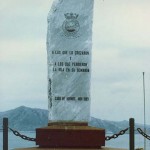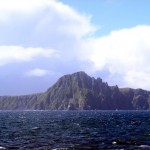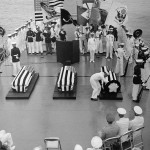Archive for the 'Uncategorized' Category
 A second memorial on Cape Horn can be found within walking distance of the Albatross Memorial featured in a previous post. This memorial, like the Albatross, pays tribute to those who have lost their lives in the transit of Cape Horn – but it also pays tribute to those who successfully made the journey in the three-hundred years of commercial sail and exploration in the great windjammers.
A second memorial on Cape Horn can be found within walking distance of the Albatross Memorial featured in a previous post. This memorial, like the Albatross, pays tribute to those who have lost their lives in the transit of Cape Horn – but it also pays tribute to those who successfully made the journey in the three-hundred years of commercial sail and exploration in the great windjammers.
Translated, the monument reads:
“To those who have crossed it and to those who have lost their lives to its demands.”
Cape Horn…
For almost 600 years mariners have considered this single geographic spot to be the end of the world. Talk to anyone who has ever sailed on the oceans and the words ‘Cape Horn’ contain equal measures of dread, mystery, and anticipation. Cape Horn is the ultimate challenge – Cape Horn is their deepest fear.
Books abound about the challenges of sailing around Cape Horn. Two of the very best are Two Years Before the Mast by Richard Henry Dana, Jr. and The Last Time Around Cape Horn (The Historic 1949 Voyage of the Windjammer Pamir) by William F. Stark. Much more will be written about the ill-fated Pamir in later posts. The history of the Pamir is fascinating – fifty years under sail in war and peace under national several flags. Stark’s fine book tells the story of Pamir’s final journey around Cape Horn – which turned out to be the very last navigation around Cape Horn by any commercial sailing vessel.
A voyage around Cape Horn under sail is generally defined as a voyage of at least 3,000 nautical miles which must pass through 50 degrees South Latitude in both the Atlantic and Pacific (or Indian) Oceans. This would place the vessel only 600 nautical miles north of Antarctica. ‘Under Sail’ means that the use of any propulsion except the wind is prohibited. It is a challenge and it is dangerous, but once it was somewhat common. Today it is an extremely rare event – best said in a quotation from the web site of the International Association of Cape Horners:
“Cape Horn is sometimes called the Mount Everest of sailing. Mount Everest was first climbed on 29th May, 1953. We believe that, since that date, fewer people have qualified for full membership of the IACH than have climbed Mount Everest.”
A superb site to discover the IACH and the history of sailing Cape Horn can be found at http://www.capehorners.org/. Take the time to visit and browse their ‘Related Items’ page. It will take you to the web sites of their international chapters, links to videos of sailing Cape Horn, satellite photographs of the area – even information on visiting the area. Perhaps no other spot on earth contains as many souls lost at sea
First and foremost, the beautiful photograph and poem seen on my previous post was directly taken from a web site of the Chilean chapter of The Amicale Internationale des Capitaines au Long Cours Cap Horners – The International Association of Cape Horners. This association has chapters in several countries. Full membership in the I.A.C.H. is available only “for those who have voyaged around Cape Horn under sail”. This must be an exclusive club indeed.
Please visit http://www.caphorniers.cl/CH_monument.htm to read the fascinating details about the design and construction of this beautiful memorial at the end of the world.
My next post will discuss more about the I.A.C.H., links to their web sites worldwide, and much more about the legendary Cape Horn.
Designed by Lissette Moreno
Copyright © 1999 – 2010 Brotherhood of Cape Horners – Chilean Section.
All rights reserved.
 |
|
On this Memorial Day it seems an appropriate time to share the story of the selection of the WWII Unknown Soldier – and of the burial at sea of another WWII unknown soldier.
The Unknown Soldier of WWII was not selected until 1958. Nineteen bodies of unknown American soldiers (thirteen from the European Theater of Operations and six from the Pacific Theater) were exhumed from cemeteries in Europe, Africa, the Philippines and Hawaii. All nineteen remains were placed in identical caskets. The European unknowns were shipped to the U.S. cemetery in Epinal, France. The Pacific unknowns were shipped to Hickam Air Force Base, Hawaii. One set of remains was selected from each Theater of Operation – the European unknown selected by an Army General and the Pacific unknown by an Air Force Colonel. The remains not selected were reburied in France and Hawaii. The two caskets remaining were eventually transferred to the U.S.S. Canberra, a guided-missle frigate resting outside the Virginia Capes, along with the Unknown Soldier of the Korean War, also selected in Hawaii from four unknowns from that conflict. Three morticians aboard the Canberra took turns changing the positions of the caskets of the WWII dead, each time alone in a closed space, in total secrecy. The Korean War Unknown Soldier was then placed on the deck of the Canberra, with the two remaining WWII unknowns placed on each side. To quote the official Arlington Cemetery account:
“Navy Hospitalman 1st Class William R. Charette, then the Navy’s only active-duty Medal of Honor recipient, selected the Unknown Soldier of World War II. The remaining casket received a solemn burial at sea.
It’s almost hard to comprehend the journey of the American soldier who was buried at sea from the U.S.S. Canberra that day. It has to be one of the strangest journeys to a final resting place in history. One can only contemplate the endless mystery. Where was he born and raised – the Kansas prairie, the Bronx, the Maine coast, the Arizona desert – or was he an immigrant from Naples or Dublin or Manila? Did he die at Normandy, Guadalcanal, Peleliu, or over the skies of Germany? Was he once buried next to his close comrades and his friends – or was he originally buried in a grave next to no one he ever knew? One thing is probably certain, however, the very instant before he died he never expected to be buried alone at sea off the Virginia Capes more than a decade later.
Navy Hospitalman 1st Class William R. Charette selects the Unknown Soldier of WWII on the deck of the U.S.S. Canberra (May 1958). The center casket contains the remains of the Korean War Unknown Soldier. The casket on the left would be buried at sea off the Virginia Capes.
Additional information on the selection of the WWII Unknown Soldier can be found at these two fascinating websites:
http://www.arlingtoncemetery.org/visitor_information/tomb_of_the_unknowns.html
http://www.arlingtoncemetery.net/unk-w2ko.htm


